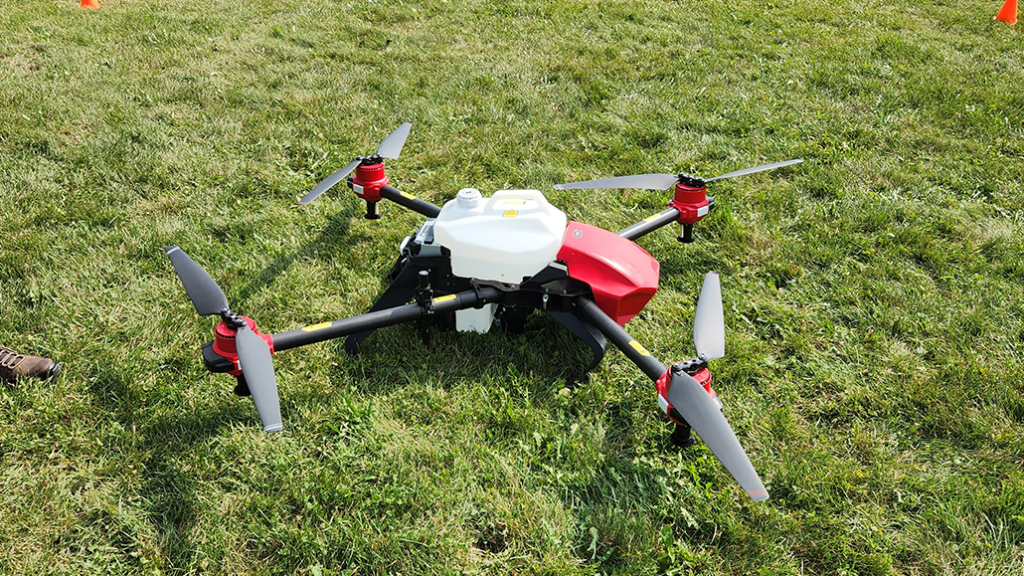Crop management from above
DRONES ON THE FARM

| WHAT YOU NEED TO KNOW • Drone technology is not new, but its on-farm use continues to grow as industry, agronomists, and farmers test and adopt new ways of integrating them into the cropping plan. • At an ONFARM demonstration event in July, drones were used to seed a cover crop on the farm of Jennifer and Mike Doelman from Douglas, Ontario. • Agronomist and farmer Kaye McLagan uses a drone to scout fields and to conduct corn plant stand counts. • Spraying crop protection using a drone is not currently legal in Canada, but is a promising future use of drone technology once approved. |
WE CAN’T USE them yet for spraying crop protection products, but drones are already being actively used by many farmers in Ontario and beyond in other ways to make crop management better and easier.
“I think they have great potential for seeding cover crops, in the springtime for red clover and in the fall,” says Jennifer Doelman, who farms with her husband Mike Doelman in Douglas, Ontario. In late August, the Doelmans hosted a demonstration of drone seeding by DJI Agricultural Drones distributed in Canada by WONDERFULL, part of a demonstration day given by the Ontario Soil and Crop Improvement Association (OSCIA) for about 70 attendees.
Doelman is one of 33 farmer co-operators participating in the On-Farm Applied Research and Monitoring (ONFARM) — a four-year applied research initiative that began in 2019 that OSCIA delivers on behalf of the Ontario Ministry of Agriculture, Food and Rural Affairs.
On the demo day, the benefits of drone seeding cover crops were especially clear. “It rained until an hour before the meeting began, and we certainly couldn’t have taken any wheeled machine into the field,” says Doelman. “This gave us a chance to seed when moisture wasn’t limiting, with no compaction and no crop damage. We’ll see if we were successful or not.”
Madeline Rodrigue, OSCIA program analyst, notes that another ONFARM co-operator, Aaron Bouwman, spread red clover using a drone last season and “seemed impressed” with the result.
“We were also able to connect the drone controller to OSCIA’s Mobile Soil Technology Suite’s large LED screen, so in addition to seeing the drone spread the seed over the field, attendees could see how the drone controls work and what it looks like from the operator’s perspective,” says Rodrigue.
BEYOND SEEDING
Drones are also used for scouting in Ontario. “It’s very difficult to determine precise density and health of crops mid-season,” says Umaid Imran of Ontario-based Fiza Drones. “Once you have plant health information, you can use a drone to spray-apply foliar fertilizer for in-season micronutrient deficiencies or do targeted conventional application of crop protection products as needed.”
Agronomist Kaye McLagan is among those who use a drone to check crop plant health — mostly nutrient deficiency and disease monitoring in soybeans and wheat early in the season on her farm and the farms of her clients through her business Willowgrove Ag Services. She farms with her brother Kevin McLagan and husband Andrew Ehgoetz outside Mitchell, Ontario.
Early in the season, the sensors on her ‘Drone Deploy’ drone also allow her to identify weed patches in soybeans, wheat, and corn. At that point, when crop plants are small, field areas where the vegetative index readings are high generally indicate a flush of weeds. McLagan then visits those areas to confirm the weed species and extent of growth, giving her the information she needs to make an informed decision about the right herbicide application.
“Also, this year, I used my drone for corn plant stand counts,” McLagan says. “I finished in less than ten minutes, and it normally takes two hours. That has been really helpful during the last two years in particular. Two years ago and even this year, we had cool and wet springs, and it’s been very helpful to see what plant stands we got for the seeding rates and the plants per acre for earlier and later planting dates. It’s really shown that later is better.”
Imran adds that at the end of the season, drones can provide insight into which fields are best harvested first.
ROI AND TRAINING
Drone operators must take a training course and pass operational and written tests. Among other restrictions, drones can only be operated in Canada in sight of the operator.
In Doelman’s view, both the time and cost involved with drones present challenges to adoption. “I think many farmers will underestimate the learning curve to operating the drone and being able to build in the proper habits on how it’s used,” she says.
This challenge is why Fiza Drones is developing an autonomous, high-speed drone system where the farmer only needs to choose flight objectives within the accompanying smartphone app. The drone takes care of gathering the data and providing the analysis.
As with any technology, the return on investment for drones depends on many factors, from the extent and types of use, individual farm parameters, how results are used, and more.
“For smaller acreage farms that have higher value crops, drone use might make a lot of sense,” says Doelman. “For newer farmers that can’t afford a sprayer or farmers in underserviced areas, it seems like a no-brainer for someone to purchase one for their own cover crops and to be hired out for custom application by their neighbours. You just need to have a dedicated person who will make sure it’s running and not sitting in the corner of the garage most of the year.”
McLagan says her drone (and four batteries) cost $3,500 and paid for itself within two years, and the $800 yearly subscription pays for itself many times over every year. This payback comes from direct interventions in crop management that lead to better yields but also in what she calls ‘knowledge profit.’ This refers to how the drone system allows farmers to build their knowledge base of many things, from variety and hybrid performance to specific field problems, best planting dates and more, giving insight for future decision making.
Imran believes a revolution in drone use has already started, partially because drones will become more and more autonomous each year. Their uses in farming are sure to expand as well, which will further drive adoption.
If spraying crop protection products by drone does become legal, Doelman says she sees “a great deal of opportunity” for this use in rural and remote areas.
“Suddenly, you don’t need to have to worry about road width, fence lines, or even accessing staff who can operate a big sprayer or the heavy trucks or tractors needed,” she says.
Doelman is also curious to see if drones will be of use to deter wildlife from damaging crops, including crows and other birds, bears, deer, and wild pigs. •























